|
|
|
Sort Order |
|
|
|
Items / Page
|
|
|
|
|
|
|
| Srl | Item |
| 1 |
ID:
178176
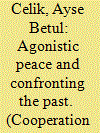

|
|
|
|
|
| Summary/Abstract |
This study analyzes how peace processes in socio-political environments that do not support ‘confronting the past’ (CTP) initiatives are affected by the exclusion and delegitimization of alternative narratives different from dominant ones concerning the nature and history of ethnic conflicts, focusing on Turkey’s failed peace process as a case study. It pays specific attention to the resistance against acknowledging alternatives to dominant narratives by considering the role played by bystanders and antagonistic citizens, who are not directly part of the conflict but nonetheless support it by remaining passive or directly/indirectly supporting dominant narratives. Driven by agonistic peace theory, the article shows how failing to turn these groups into agonistic citizens through some form of agonistic CTP initiative and allowing a space for alternative narratives can result in the fragility of efforts towards a transition to peace.
|
|
|
|
|
|
|
|
|
|
|
|
|
|
|
|
| 2 |
ID:
155238
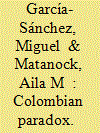

|
|
|
|
|
| Summary/Abstract |
Ending civil conflict is difficult, particularly through political settlements. Conflicts now often occur in states with elections, and voters have sometimes been directly involved in the process, potentially in efforts to overcome elite divisions. Yet, according to evidence from the 2016 popular plebiscite in Colombia, referendums and other tools of direct approval by voters seem to amplify elite divisions and therefore are not a useful mechanism to strengthen peace processes in this way. Focusing instead on traditional elite-led negotiations that seek to satisfy each faction may have a better chance of producing signed settlements, although the Colombian case also suggests some alternative forms of inclusivity that may help increase the overall legitimacy of the process and improve the odds of implementation.
|
|
|
|
|
|
|
|
|
|
|
|
|
|
|
|
| 3 |
ID:
178178
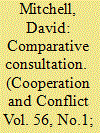

|
|
|
|
|
| Summary/Abstract |
Exchanges of expertise and experience between personnel involved in different peace processes are now a common feature of peacemaking worldwide. However, the goals, methods and impact of such interactions have been subject to little research. This article is the first scholarly analysis of what is here called ‘comparative consultation’. The article begins by conceptualising this work as a unique form of Track Two unofficial diplomacy, sharing the practical format and theoretical grounding of other Track Two approaches but differing in content. The empirical section is based on semi-structured interviews with 16 practitioners – primarily conflict resolution non-governmental organisation personnel and academics – who have facilitated dialogues on peace process topics (such as negotiation, transitional justice, grassroots peacebuilding) between peace process actors at various levels and from many contexts. It also draws on the author’s participation in a series of comparative consultation events. The findings focus on aspects of the organisation, purpose and potential, and limitations and possible risks of the practice. The conclusion sets out a model of the dimensions and potential impacts of comparative consultation and argues for its recognition as a distinct peace methodology. Avenues for further research and practice are outlined.
|
|
|
|
|
|
|
|
|
|
|
|
|
|
|
|
| 4 |
ID:
111575
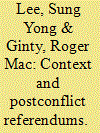

|
|
|
|
|
| Publication |
2012.
|
| Summary/Abstract |
This article argues that referendums in societies coming out of war often fit into the conflict resolution rather than the conflict transformation paradigm. As conflict resolution devices, they may be one-off events rather than part of a longer term attempt to recalibrate relationships between antagonistic groups. Using a number of case studies, the article argues that unless the ground is prepared beforehand, referendums may have a limited ability to bring about reconciliation. Some well-timed referendums have advanced peace processes at critical moments, but these are exceptions and we should be cautious in recommending them as exemplars to other cases. The article highlights three common contextual issues that limit the conflict amelioration possibility of referendums: the exclusion of key constituencies from debates on the referendum process, a lack of voter education, and generalized insecurity.
|
|
|
|
|
|
|
|
|
|
|
|
|
|
|
|
| 5 |
ID:
168439
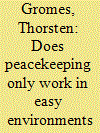

|
|
|
|
|
| Summary/Abstract |
Peacekeeping is widely considered to be an effective means of preventing civil war recurrence. However, as peace has collapsed in a considerable number of cases despite peacekeeping efforts, we are left with the question which combinations of peacekeeping environments and peacekeeping missions lead to lasting peace. This article compares 22 peacekeeping missions between 1990 and 2012. While prominent United Nations documents assume that the success of post-conflict peacekeeping primarily depends on the features of the mission itself, the analysis shows that characteristics of the terminated civil war have a strong influence on whether peace endures. Restrained peacekeeping, defined by low troop density, non-robustness, and a lead nation that is not a permanent member of the Security Council, only succeeds in preserving peace in conducive environments. Inconclusive war endings, evenly distributed military capabilities at war’s end, ethnic conflicts, and high intensity create a particularly difficult context for peacekeeping.
|
|
|
|
|
|
|
|
|
|
|
|
|
|
|
|
| 6 |
ID:
141588
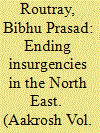

|
|
|
| 7 |
ID:
181128
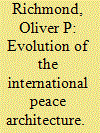

|
|
|
|
|
| Summary/Abstract |
The theories and doctrines related to peacekeeping, mediation, peacebuilding, and statebuilding, as well as other tools used to end war and conflict, raise a range of long-standing questions about the evolution and integrity of what might be called an international peace architecture. A narrow version of this term has begun to appear in the context of peacebuilding through the United Nations, the African Union, the European Union, other regional actors, the international legal system, and the International Financial Institutions. This article proposes a much broader, historical version, with six main theoretical stages, which have, from a critical perspective, produced a substantial, though fragile, international architecture.
|
|
|
|
|
|
|
|
|
|
|
|
|
|
|
|
| 8 |
ID:
187032
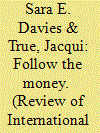

|
|
|
|
|
| Summary/Abstract |
The Women, Peace and Security (WPS) agenda and women's participation in peace processes are strongly supported by states. Yet financing to support the implementation of WPS has lagged behind overt international commitments to the agenda. WPS scholars and practitioners have highlighted the funding shortfalls for enabling WPS implementation and continued under-investment in gender-inclusive peace. In this article, we ask how much are donor states financially backing the implementation of gender-inclusive peace agreements which they promote? We use a high ambiguity-conflict model of policy implementation to explore the mechanisms of bilateral and multilateral financing for gender-inclusive peace. We trace to what extent international investments are supporting specific gender provisions in two progressive gender-inclusive peace processes, the 2016 Colombian Peace Agreement and 2015 Comprehensive Peace Agreement in the Philippines. In both case studies, we reveal a drastic gap between the international donor rhetoric and the funding. Patterns of financial investment do not follow nor support the life cycle of inclusive peace processes. We suggest key strategies for further research to address this policy and recommend that all gender provisions of peace agreements be monitored in-country and all gender-responsive investments be tracked and evaluated.
|
|
|
|
|
|
|
|
|
|
|
|
|
|
|
|
| 9 |
ID:
181833
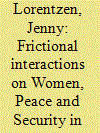

|
|
|
|
|
| Summary/Abstract |
More than 20 years after the adoption of UN Security Council Resolution 1325 on Women, Peace and Security, the international community is concerned with taking stock of its implementation in countries undergoing transitions from war to peace. This article contributes to a better understanding of the dynamics involved in implementing the Women, Peace and Security agenda through a focus on the frictional interactions that take place between different actors promoting women's participation in the peace process in Mali. Based on extensive fieldwork in Bamako between 2017 and 2019, it analyses interactions between different international and local actors in the Malian peace process through a discussion of vertical (between international and local actors) and horizontal (between local actors) friction. It finds that the way different actors respond to friction shapes relationships and impacts norm trajectories by triggering feedback loops, which in turn trigger new responses and outcomes.
|
|
|
|
|
|
|
|
|
|
|
|
|
|
|
|
| 10 |
ID:
106590
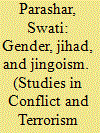

|
|
|
|
|
| Publication |
2011.
|
| Summary/Abstract |
The Kashmir case is a conundrum in the study of women's roles in religio-political militancy. While traditional social structure and gendered hierarchies have been retained, public spaces have also been available to women to don more political and militant roles. This article looks at the multiple roles of women in the militancy in Kashmir and the discourses around them. Women's participation in the militancy has not found any mention in the nationalist narratives and Kashmiri women struggle to claim their share in the contemporary political discourse. Ambiguities remain about how the male-dominated Kashmiri nationalist and conflict discourse may have influenced inclusions and exclusions. Through a case study based on interviews conducted in Kashmir, this article argues that women's violent activities or their support to the militancy is altogether excluded or maneuvered to preserve existing gender norms and patriarchal traditions. This has dangerous implications as it tends to exclude women's voices in the peace processes.
|
|
|
|
|
|
|
|
|
|
|
|
|
|
|
|
| 11 |
ID:
165663
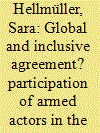

|
|
|
|
|
| Summary/Abstract |
This article provides an analytical framework to understand how participation of armed actors in peace negotiations influences local violence. It argues that the link between violence and exclusion or inclusion of armed actors is often indirect and depends on armed actors’ underlying motivations to be included and their corresponding strategies. Based on an analysis of the Congolese peace process from 1999 to 2003, the article assesses how the mandate of the peace process influenced armed groups’ motivations to be included. It then analyzes the strategies that armed actors used to be included and examines their impact on local violence. Thereby, it allows for a more nuanced understanding of how participation of armed actors in a mediation process influences prospects for peace.
|
|
|
|
|
|
|
|
|
|
|
|
|
|
|
|
| 12 |
ID:
116875
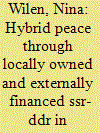

|
|
|
|
|
| Publication |
2012.
|
| Summary/Abstract |
This article aims to critically examine Rwanda's security sector reform and disarmament, demobilisation and reintegration (ssr-ddr) process through a theoretical framework outlining four different models of peace processes in order to identify the sort of peace that can emerge from Rwanda's ssr-ddr approach. The author analyses how the Rwandan government has managed to keep the process 'locally' owned, while largely financed by external actors, despite strong criticism of its apparent lack of democratisation. The 'genocide credit', the Rwandan government's preference for national, rather than international solutions and its recent troop contribution to peacebuilding operations in the region are identified as the main reasons for this development. The paper argues that the peace emanating from the ssr-ddr process may be considered a hybrid form of state formation and state building, because of the local agency's preference for security and stability while simultaneously enjoying financial and technocratic support for its 'liberal' peacebuilding actions in the region.
|
|
|
|
|
|
|
|
|
|
|
|
|
|
|
|
| 13 |
ID:
176502
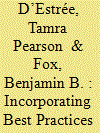

|
|
|
|
|
| Summary/Abstract |
Track Two processes were developed to facilitate movement in difficult international conflicts. Since Montville first coined the term, Track Two processes have considered deliberate and strategic ways to bring together adversaries in unofficial, private face-to-face interactions that allow for joint analysis and mutual learning. Such processes create the conditions for more nuanced problem definition and solution exploration. Ideally, these insights are then transferred into official peace processes, policymaking and decision-making. Transfer acknowledges a strategic dimension to planning for change; Track Two approaches abridge and accelerate the long-term accumulation approach by the strategic choice of participants, agenda and goals. This article reviews and summarizes our knowledge to date about how best to encourage Track Two inputs into negotiation and other Track One diplomatic efforts. It then offers a checklist for designing initiatives to best promote both intergroup learning and timely transfer to generate effective change.
|
|
|
|
|
|
|
|
|
|
|
|
|
|
|
|
| 14 |
ID:
190761
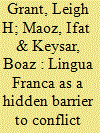

|
|
|
|
|
| Summary/Abstract |
Longstanding intergroup conflict is one of the most perilous issues on the global stage, leading to violence, displacement, and loss of life. Finding strategies to bring parties to the negotiation table is therefore of utmost importance for conflict resolution. Here we address a common problem in intergroup conflict - the lack of a shared, native tongue - which is typically solved by using a lingua franca. Three experimental studies revealed that a peace-building proposal presented in a lingua franca is perceived as less favorable to one’s own side than a proposal presented in one’s native tongue. Specifically, our studies demonstrated that the use of a lingua franca elicits higher levels of hatred and lower levels of sympathy, thereby reducing the perceived favorability of the proposal. Broadly, these findings indicate that the seemingly innocuous choice of the language could have serious implications for conflict resolution as well as for international diplomacy.
|
|
|
|
|
|
|
|
|
|
|
|
|
|
|
|
| 15 |
ID:
167278
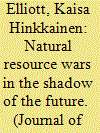

|
|
|
|
|
| Summary/Abstract |
Previous studies on natural resources and civil wars find that the presence of natural resources increases both civil conflict risk and duration. At the same time, belligerents often cooperate over resource extraction, suggesting a temporal variation in the contest over this subnational space. This study argues that parties fight over natural resources primarily when they expect that the conflict is about to end, as the importance of controlling them increases in the post-conflict setting. In contrast, belligerents that anticipate a long war have incentives to avoid fighting near natural resources since excessive violence will hurt the extraction, trade, and subsequent taxation that provide conflict actors with income from the resource. We test our argument using yearly and monthly grid-cell-level data on African civil conflicts for the period 1989–2008 and find support for our expected spatial variation. Using whether negotiations are underway as an indicator about warring parties’ expectations on conflict duration, we find that areas with natural resources in general experience less intense fighting than other areas, but during negotiations these very areas witness most of the violence. We further find that the spatial shift in violence occurs immediately when negotiations are opened. A series of difference-in-difference estimations show a visible shift of violence towards areas rich in natural resources in the first three months after parties have initiated talks. Our findings are relevant for scholarship on understanding and predicting the trajectories of micro-level civil conflict violence, and for policymakers seeking to prevent peace processes being derailed.
|
|
|
|
|
|
|
|
|
|
|
|
|
|
|
|
| 16 |
ID:
153846
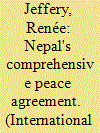

|
|
|
|
|
| Summary/Abstract |
In November 2006, the Government of Nepal and the Communist Party of Nepal-Maoist signed a Comprehensive Peace Agreement (CPA) designed to bring more than a decade of violent conflict to an end. At its heart stood a commitment to ending impunity for the significant number of human rights violations perpetrated during the conflict. In particular, by refusing to grant amnesties to perpetrators of human rights abuses and by agreeing to impartial investigations of alleged human rights crimes, Nepal seemed willing to embrace globally accepted anti-impunity and accountability norms. A decade on, however, impunity for human rights violations continues to prevail in Nepal, while accountability efforts are routinely resisted and even obstructed by members of the ruling elite. With this in mind, this article examines the range of factors that have allowed impunity to prevail over accountability in post-conflict Nepal. It argues that despite the efforts of the international community, civil society actors and local human rights activists to remove impunity guarantees from Nepal's peace agreement, shifting political dynamics, competing interests, and a genuine lack of political will have allowed impunity to flourish in the post-conflict period.
|
|
|
|
|
|
|
|
|
|
|
|
|
|
|
|
| 17 |
ID:
104291
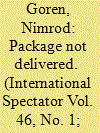

|
|
|
|
|
| Publication |
2011.
|
| Summary/Abstract |
Incentives are capable of creating favourable environments in which peace processes can make progress. This is especially true for mega incentives, which can assist in overcoming political and socio-psychological barriers to peace. In Israeli-Arab peacemaking, incentives have not yet proven efficient. To date, they have been used in a limited and inefficient manner. In 2010, the US offered Israel incentives in return for an extension of Israel's settlement freeze. This move failed due to unfavourable political conditions and scepticism regarding its ability to bring about a major breakthrough. Nevertheless, it signaled that incentives are now an integral tool in US diplomacy and could serve as a step towards crafting a multi-national mega incentive package for Middle East peace.
|
|
|
|
|
|
|
|
|
|
|
|
|
|
|
|
| 18 |
ID:
129483
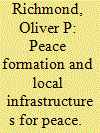

|
|
|
|
|
| Publication |
2013.
|
| Summary/Abstract |
The interaction of processes of state formation, liberal peacebuilding and statebuilding and localized practices of peacemaking-or what might be called peace formation-offer the prospect of forms of peace that may be both locally and internationally legitimate. Post-liberal and hybrid forms of peace influenced by local patterns of politics, based on contextual social, cultural and historical, norms, identities, and material resources, as well as cognizant of international norms, not to mention power, may represent a more accurate characterization of the results of peace processes worldwide. This article examines local processes of peace formation and emerging peace infrastructures.
|
|
|
|
|
|
|
|
|
|
|
|
|
|
|
|
| 19 |
ID:
165662
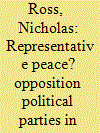

|
|
|
|
|
| Summary/Abstract |
This article presents four case studies in which peace was negotiated between governments and political opposition parties, and in which major armed groups involved in the conflict were excluded from some or all of the negotiations. The inclusion of opposition political parties and exclusion of some armed actors in these cases derived from the desire of mediators and some of the parties to foreground political concerns (at the expense of military considerations). Opposition political parties were able to play a role in bringing armed groups into peace settlements under some conditions, although strong international pressure and support helped to create the preconditions for this role. This evidence suggests a challenge to arguments that major armed groups must be included in peace negotiations if they are to abide by the resulting peace settlement.
|
|
|
|
|
|
|
|
|
|
|
|
|
|
|
|
| 20 |
ID:
110268
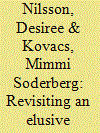

|
|
|
|
|
| Publication |
2011.
|
| Summary/Abstract |
In a seminal article, Stedman (International Security, 22, 1997, 5) suggested that the greatest source of risk to civil war peace processes comes from so-called spoilers, leaders, and groups that perceive peace as threatening and use violence to undermine attempts to achieve it. The spoiler concept has since gained significant ground and widespread legitimacy both in the academic literature and in critical policy circles. In the footsteps of this development, however, we suggest that the spoiler concept has been stretched beyond its original meaning and given raise to a number of ambiguities concerning its definition and empirical applicability. This lack of clarity in regard to some of the key aspects of the spoiler concept does not only risk undermining the usefulness of the concept itself, but also risks hampering the accumulation of valuable research on this pertinent topic. This article presents a reflection on a burgeoning research field and aims to contribute to the same by attempting to offer greater conceptual clarity in regard to a number of issues that are the core of the spoiler debate and by presenting a conceptual framework for analyzing spoilers in future research.
|
|
|
|
|
|
|
|
|
|
|
|
|
|
|
|
|
|
|
|
|